I tried cupping, a Chinese therapy Olympic swimmers swear by. It loosened my neck, and I slept like a rock that night.
Anna Medaris Miller

- Cupping is a Chinese medicine therapy used for pain relief and to speed recovery in athletes.
- I tried it to relieve neck tension and was surprised how enjoyable the sliding technique was.
- My neck and upper backed turned bright red, but all marks faded within days.
When Michael Phelps showed up to the 2016 Olympics with deep purple bruises dotted across his shoulders and back, much of the world was intrigued.
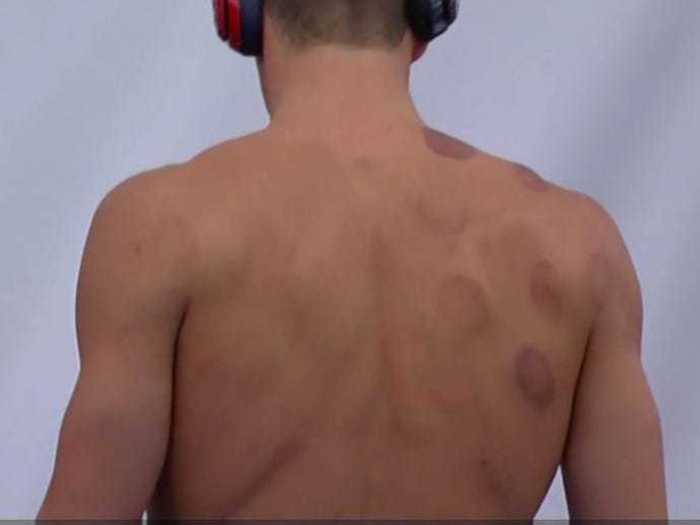
"What are those strange marks?" Insider asked back then.
Now, the therapy that caused the circles, called cupping, is more mainstream. Gwyneth Paltrow and Lena Dunham do it. My sister-in-law has done it. And, plenty of Olympians currently competing in Tokyo are doing it — and, unlike the last Olympics, few are raising their eyebrows.
But I — a recreational swimmer and health journalist — had yet to try this bizarre-looking treatment. So I headed to the closest Chinese medicine studio, less than two blocks from my house, and gave it a shot.
Cupping is a Chinese medicine therapy involving suction cups to promote blood circulation.
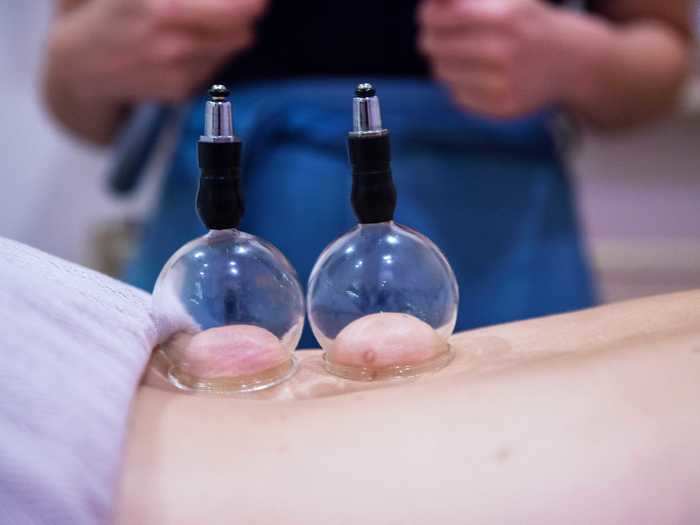
My practitioner, Sandra Lanshin of Treatment by Lanshin, told me the blood in the capillaries right beneath the skin's surface should move freely through the body like a river.
"In order to feel good in your body and to be healthy, you shouldn't really feel your body in a way," she said.
But tense tissue and other ailments can lead to more stagnation in the "river," like swampy water beginning to pool. Cupping aims to release that clogging through suction, Lanshin said.
The therapy is mostly used to treat pain and tension, but Lanshin said it can also help relieve headaches.
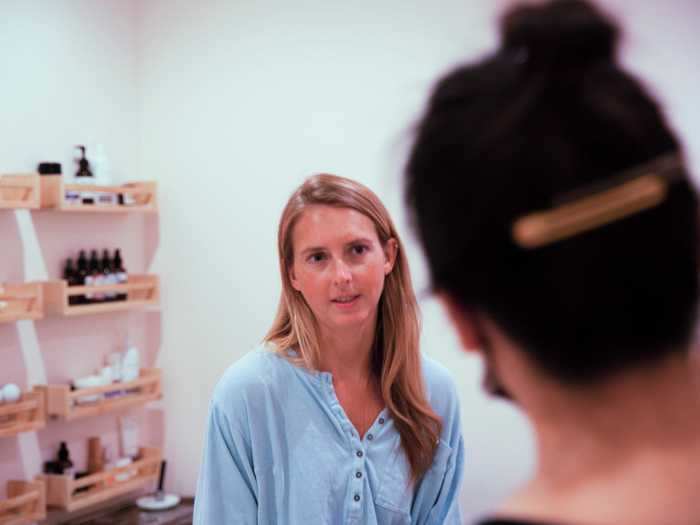
In Chinese medicine, the body isn't understood as just organs and bones and tissues, but also as an energy system that's all interrelated.
There are points on the back, Lanshin explained, believed to relate to certain organs, and so therapies including cupping and acupuncture can tap into them — attempting to ease coughing, for example, by putting a suction on the area connected to the lungs.
For elite athletes, cupping is believed to help ease discomfort, improve range of motion, and boost recovery between intense training sessions.
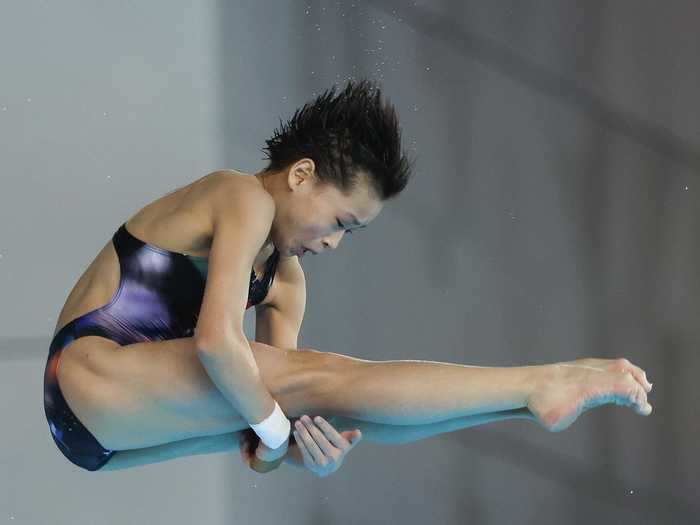
Sort of the opposite of a foam roller or massage, the therapy helps break up and deliver blood to overworked tissues.
"Think of us as an Indy Car pit crew, looking at the structure and alignment of the vehicle to see if there is any kind of drag or anything," chiropractor Kevin Rindal who worked with USA Swimming in 2016 told ESPN back then.
"And if you think of how close these racers are, a little bit of restriction adds up in each stroke and can prevent a full reach. It's basically the fine-tuning of the tissue."
It's different from another technique popular among this year's Olympians: blood flow restriction, in which athletes use bands to limit the blood to their muscles during training to stimulate muscle growth and to make racing without the bands feel easy by comparison.
My aim was to relieve upper back and shoulder tension. Before we even began, Lanshin said she could see it in my neck.
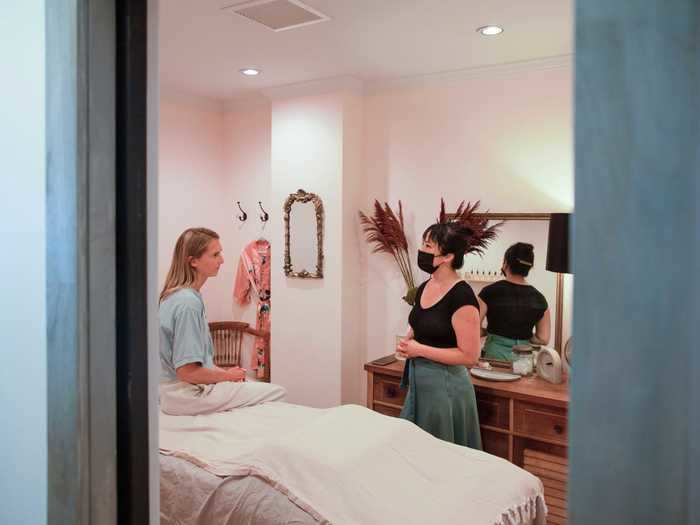
Once I was on my back, she noticed how one shoulder muscle protruded more than the other, likely a result of carrying more tension on that side due to the way I hunch over my laptop.
First, I took off my shirt and bra and lay face-down on a heated massage table. I love massages, so the spa-like atmosphere of the studio was immediately relaxing.
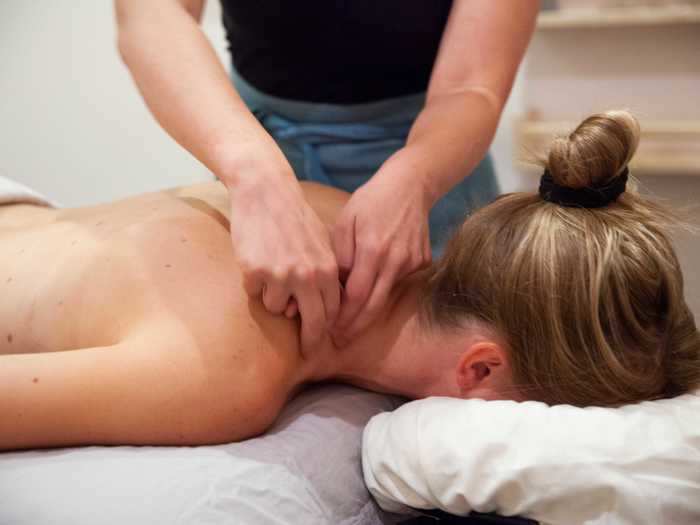
I kept my comfy pants and underwear on since cupping is usually performed on the upper body. Lanshin said you can receive the treatment on other parts of your body like your legs, but there's less loose skin and subcutaneous fat there, so you can't use as strong of a suction.
Plus, in Chinese medicine, it's largely through the back that practitioners communicate with various organs.
I was thankful Lanshin used a modern pump method rather than the traditional technique involving flames. I was prepared to leave with bruises, not burns.
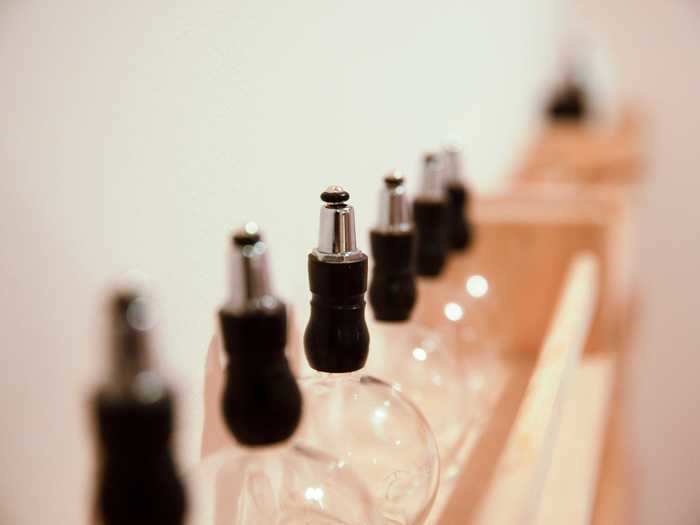
Traditionally, cupping involved lighting a flame under a glass cup "to suck out the oxygen in the cups so that when you place it on the body, it creates a vacuum," Lanshin told me.
But she doesn't use the fire method often anymore because it's tough to control the level of suction.
On me, she used cups connected to a pump that allowed her to crank up the intensity when I asked for it and dial it down when the pressure was too much.
At first, I worried about taking deep breaths - as if there wasn't enough skin left to stretch with my belly.
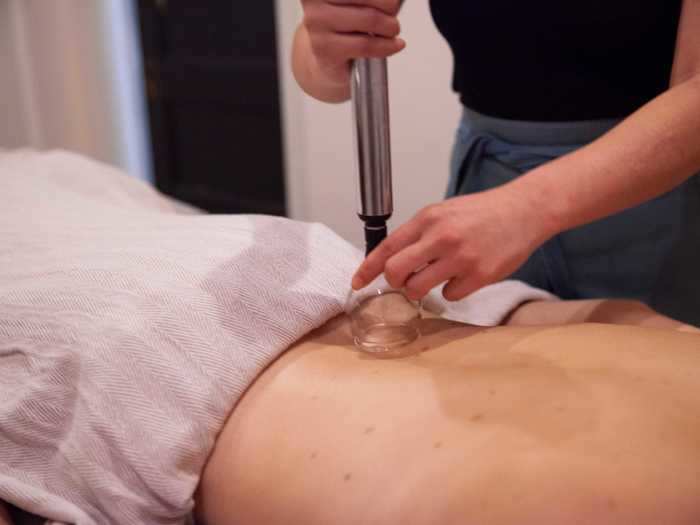
Lanshin assured me it was OK, and to go ahead and try. I was successful, but she still lightened the suction on one cup that felt uncomfortably pinchy near my left hip.
As she continued placing cups, the photographer's reaction was more dramatic than my own.
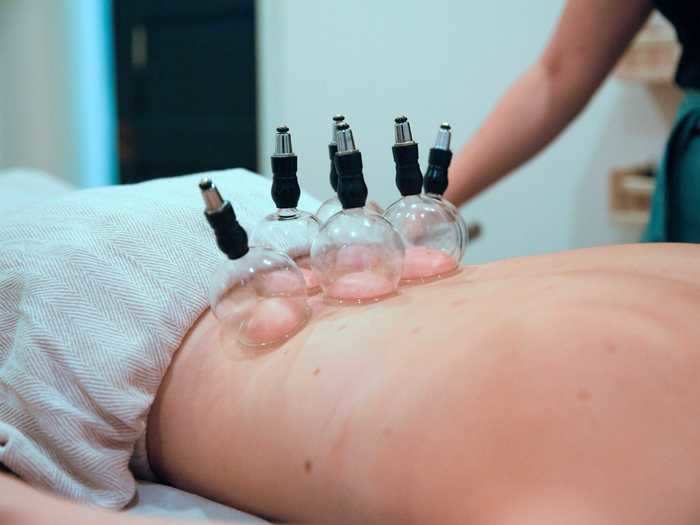
I mostly just felt some tightness and pressure. But Ryan was mind-blown watching the cups fill with my flesh that seemed to materialize out of nowhere. "Whoa! That's all her skin?" I heard him say. "That's wild!"
Lanshin stuck stationary cups on my lower back, where I have few issues, but used a more intense - and enjoyable - sliding technique on my upper back.
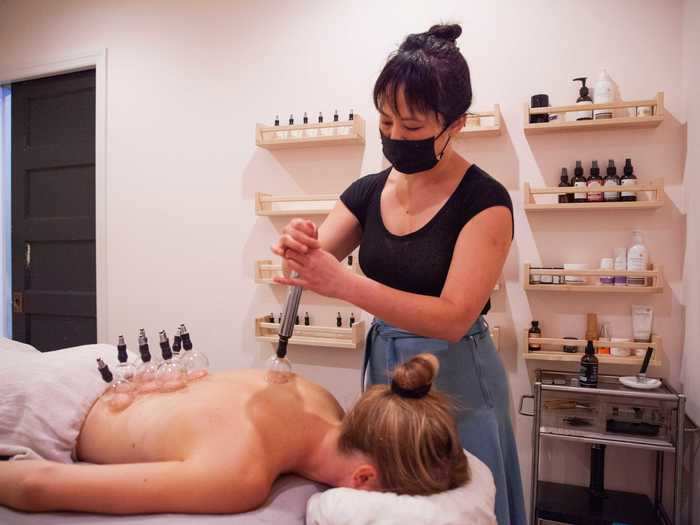
Lanshin oiled my back before placed a cup that was dialed down just enough to be able to move across my skin, pulling up the capillaries and breaking up the tissue along the way.
The technique can cover more surface area and get at particularly stubborn knots. It reminded me of a deep tissue massage, so I loved it.
"That doesn't hurt?" Ryan asked as he watched my back redden with dots of broken blood vessels.
Lanshin said the redder the skin gets, the more the treatment was needed. My upper back, she said, was on the higher end of reactions she sees, and called it "satisfying" as a practitioner.
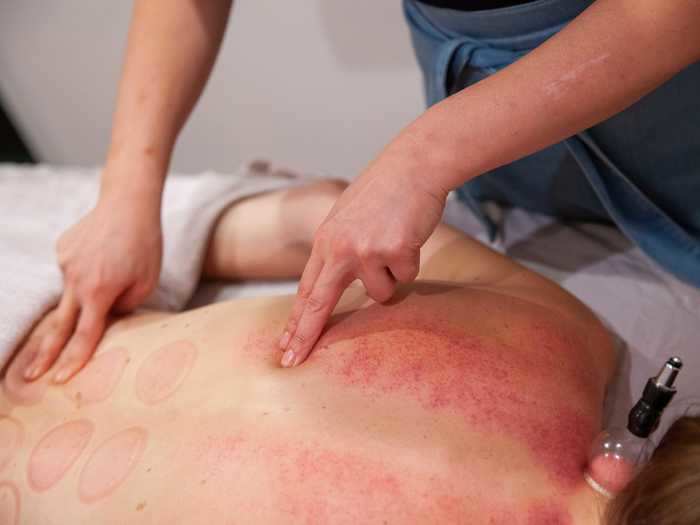
"If your tissue is really healthy, you'll just get pink and that will go away in 20 minutes to an hour," she said. "Where you have really deep stagnation or intense stagnation it can get up to like a dark purple."
The coloring can be diagnostic too, she said. Because the area of the back relates to the lungs in Chinese medicine, it could have helped explain — and relieve — chest congestion or coughing.
But since I wasn't dealing with respiratory issues, Lanshin suspected the red simply reflected serious muscle tension built up from years of desk-hunching and weight-training. Swimming was unlikely an culprit, she said, since it helps lengthen muscles and improve blood flow.
There's not a lot of rigorous research on cupping, but there aren't many downsides.
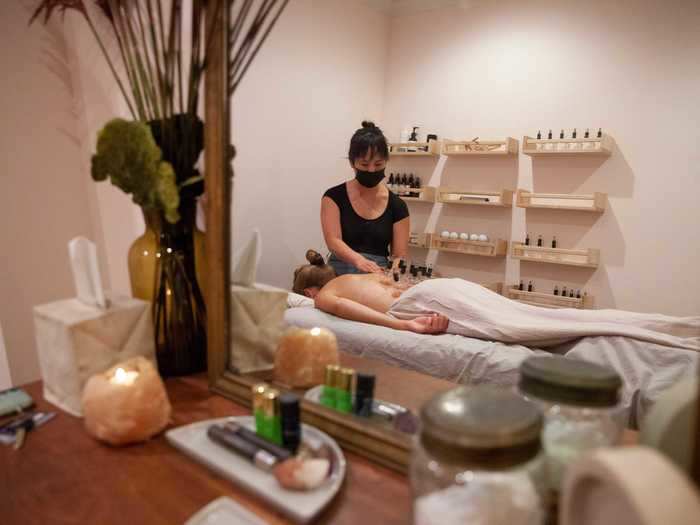
A 2020 study reviewing the research on cupping and blood flow restriction (another performance-enhancing technique trending among Olympians) found both can be beneficial and are extremely low risk. Cupping may be especially helpful for general muscle pain, however "high-quality studies are needed," it found.
From my view, like many other complementary medicine treatments, the only real downside is cost, especially if you do it regularly — some people do it as much as twice a week. 30-minute sessions tend to be between $30 and $60, and closer to $150 if you receive it with acupuncture.
It's also important not to solely rely on therapies like cupping when you in fact need a more invasive medical treatment — it's not going to heal a broken bone or cure kidney disease, nor does it claim to.
I had expected the therapy to be slightly uncomfortable, but be worth it for a looser back and perhaps improved athletic performance.
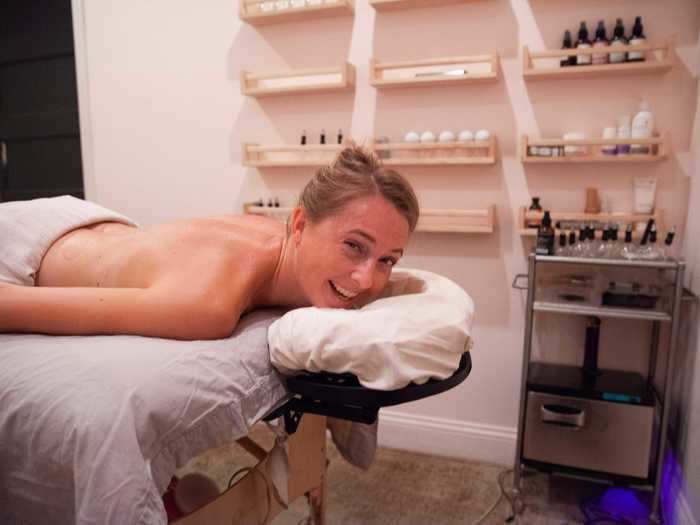
However, I was pleasantly surprised to find that the treatment itself was highly enjoyable. If you like deep tissue massages like me, cupping — especially the sliding technique — feels like the next level.
I left with what looked like a strange sunburn on my neck, and light circles on my lower back.
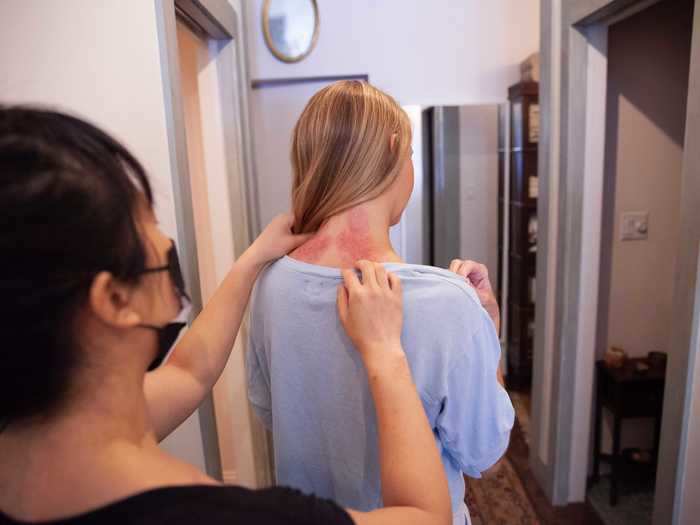
I'd also been worried that the marks would dictate my apparel the next few days, and was sure to schedule it more than a month before my wedding. But the neck redness faded by the next day, and I totally forgot about my lower back circles — even missing my chance to get a picture of them before they disappeared just a couple days later.
After my treatment, I felt more relaxed and a bit looser-necked.

I slept like a rock that night, which was welcomed. The ridge between my shoulders and neck was a bit sore the next day too, though I'm afraid I've resumed my hunching posture and associated tightness since.
I swam the next day and three times since the treatment last week, but haven't notice any differences in the pool.
Since my complaints going in to the treatment were pretty minor and my pool workouts are just 30 minutes and moderate in intensity — compared to six hours straight of training for Olympic swimmers — it's understandable I didn't experience huge changes.
Most people seek out cupping for pain, in which case relief would be more noticeable, Lanshin said. And elite athletes who need quick recovery between events or training sessions may find they can race at a higher intensity after recruiting the extra blood flow to their tissues.
For me, though, cupping is definitely a "treat" more than a "treatment" — and one I'd gladly do again.
READ MORE ARTICLES ON
Popular Right Now
Popular Keywords
Advertisement